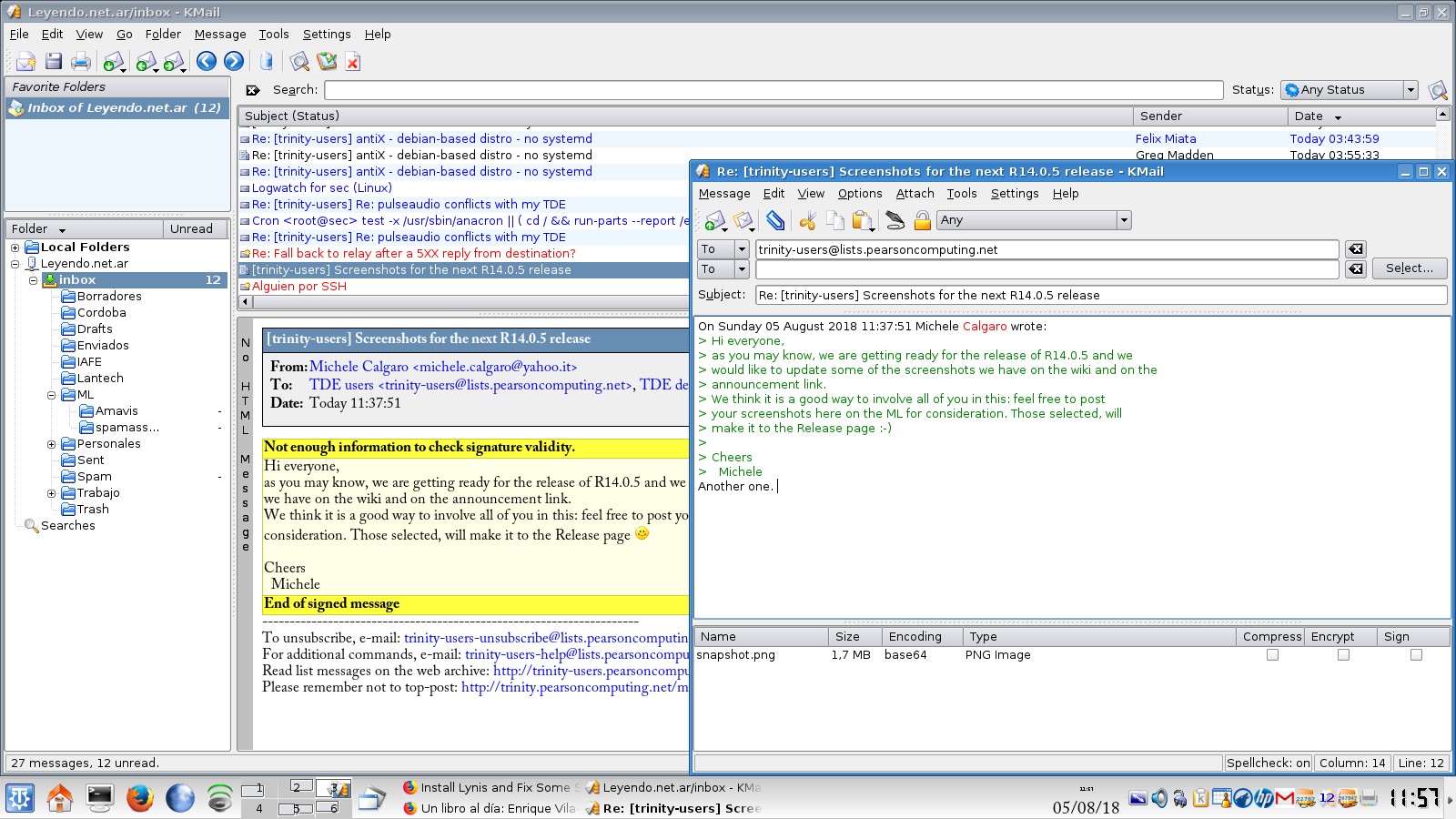Difference between revisions of "KMail"
imported>Waves (kmail quirks) |
(Improve page structure and wording, add screenshot, merge content from Kmail Sanitize and Decrypt Mails) |
||
| Line 1: | Line 1: | ||
[[Image:Diego Vadell 3.jpg|right|thumb|200px|A user screenshot showing KMail]] |
|||
Kmail, is the mail client of trinity. |
|||
'''KMail''' is the e-mail client of Trinity Desktop. It is part of the <tt>tdepim</tt> package. |
|||
| ⚫ | |||
The Kontact suite integrates KMail as its embedded e-mail client. |
|||
*You are forced to also install and configure "tdewalletmanager-trinity" to actually use kmail. |
|||
__TOC__ |
|||
*You can configure tdewalletmanager with out a password, and so that kmail can always start it and use it without a password. You can't avoid using it. |
|||
| ⚫ | |||
| ⚫ | |||
* You must install and set up the TDE Wallets subsystem to be able to use KMail, but you can make wallets open automatically without entering a password if you don't care about TDE Wallets. |
|||
| ⚫ | |||
| ⚫ | |||
== Filters == |
|||
KMail supports e-mail filters. Filters are automated actions that are performed on a folder when new mail arrives, or manually by the user. |
|||
=== Advanced example: Automatically decrypt and sanitize incoming mail === |
|||
This is an example how to create a filter in KMail that removes unwanted headers and automatically decrypts incoming mails, so that mail passes through the transport encrypted, but is stored decrypted on the disk. |
|||
1. Download [[File:Kmail-decrypt-and-sanitise-mail.gz]] and place it in your <tt>~/bin</tt> folder or any place else suitable for you, extract the archive and make the extracted script executeable. |
|||
<syntaxhighlight lang="shell-session"> |
|||
$ wget https://wiki.trinitydesktop.org/images/c/c1/Kmail-decrypt-and-sanitise-mail.gz |
|||
$ tar xf Kmail-decrypt-and-sanitise-mail.gz |
|||
$ mv kmail-decrypt-and-sanitise-mail /path/to/destination |
|||
$ chmod a+x /path/to/destination/kmail-decrypt-and-sanitise-mail |
|||
</syntaxhighlight> |
|||
2. Open KMail, go to <code>Settings > Configure Filters</code>. |
|||
3. Create a new filter, name it as you like and move it to the top of the list. |
|||
4. On the "General" tab leave "Filter Criteria" empty. |
|||
5. Set "Filter Actions" to "Pipe Through" and set the program path to <tt>/path/to/destination/kmail-decrypt-and-sanitise-mail</tt>. |
|||
6. On the "Advanced" tab uncheck "If this filter matches, stop processing here" |
|||
Now all incoming mails get decrypted by default (if a key is present), and some tags (find them on line 45 of the script) are removed (X-UI-Filterresults:, X-GMX-Antivirus:, …). |
|||
You can further modify the script to include other automated actions. |
|||
== Caveats == |
|||
* KMail does not support OAuth2 yet, which is required by Google and some other e-mail providers. You can try setting up an OAuth2 proxy or use another e-mail client meanwhile. |
|||
| ⚫ | |||
Revision as of 15:28, 25 September 2024
KMail is the e-mail client of Trinity Desktop. It is part of the tdepim package.
The Kontact suite integrates KMail as its embedded e-mail client.
Tips
- You must install and set up the TDE Wallets subsystem to be able to use KMail, but you can make wallets open automatically without entering a password if you don't care about TDE Wallets.
- You can use a specific outgoing account for a specific identity. (see
Settings > Identities > Modify > Advanced > Special transport).
Filters
KMail supports e-mail filters. Filters are automated actions that are performed on a folder when new mail arrives, or manually by the user.
Advanced example: Automatically decrypt and sanitize incoming mail
This is an example how to create a filter in KMail that removes unwanted headers and automatically decrypts incoming mails, so that mail passes through the transport encrypted, but is stored decrypted on the disk.
1. Download File:Kmail-decrypt-and-sanitise-mail.gz and place it in your ~/bin folder or any place else suitable for you, extract the archive and make the extracted script executeable.
$ wget https://wiki.trinitydesktop.org/images/c/c1/Kmail-decrypt-and-sanitise-mail.gz
$ tar xf Kmail-decrypt-and-sanitise-mail.gz
$ mv kmail-decrypt-and-sanitise-mail /path/to/destination
$ chmod a+x /path/to/destination/kmail-decrypt-and-sanitise-mail
2. Open KMail, go to Settings > Configure Filters.
3. Create a new filter, name it as you like and move it to the top of the list.
4. On the "General" tab leave "Filter Criteria" empty.
5. Set "Filter Actions" to "Pipe Through" and set the program path to /path/to/destination/kmail-decrypt-and-sanitise-mail.
6. On the "Advanced" tab uncheck "If this filter matches, stop processing here"
Now all incoming mails get decrypted by default (if a key is present), and some tags (find them on line 45 of the script) are removed (X-UI-Filterresults:, X-GMX-Antivirus:, …).
You can further modify the script to include other automated actions.
Caveats
- KMail does not support OAuth2 yet, which is required by Google and some other e-mail providers. You can try setting up an OAuth2 proxy or use another e-mail client meanwhile.
- Configuring a transport server with a reply address is bugged and doesn't work.
